Yurt Skiing the Swan Range
I coax my skis to the edge of the hill, just before the point where slope and lack of friction overcome inertia. The horseshoe-shaped ribs of western Montana’s Swan Range stretch out to my right. To my left, more than 3,000 feet below, lies Seeley Lake.
This is only my second time on skis in 20 years, and my first ever in backcountry powder. I couldn’t think of a better classroom.
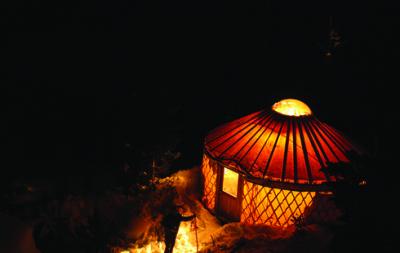
Forming the westernmost buttress of the broad swatch of peaks that comprises the Bob Marshall Wilderness Complex, the Swans lie within an hour’s drive of Missoula but well off the beaten path of the skiing masses. With an annual average annual snowpack of around 10 feet, the Swans boast some of the state’s best backcountry powder skiing, on the edge of one of the largest tracts of wilderness in the lower 48 states.
“There’s a lot of really good skiing to be had in the Swans,” says Carl Sievers, one of the co-owners, with Adam Simon, of Missoula-based Yurtski, which rents two alpine yurts near the southern tip of Seeley Lake. “They have their own mini-vortex of weather; they tend to be colder and get more snow even than their neighbors.”
“In the winter people will be complaining about the lack of snow in Missoula and you can drive your snowmobile to the gas station in Seeley Lake on the edge of the Swans,” laughs Sievers.
Snowmobiles are also a necessity for covering the eight to 10 miles of winding forest roads separating Seeley and Swan Lakes from the peaks above. Long approaches keep the ski traffic down; if you stay in one of Yurtski’s backcountry digs you’ll likely have the powder all to yourself.
The backcountry is the new frontier in the winter sports industry: in the 2009-2010 ski season, backcountry ski sales increased 57 percent over the previous year. Outfitters from West Yellowstone to Whitefish have begun to offer backcountry ski accommodations ranging from pup tents to upscale cabins.
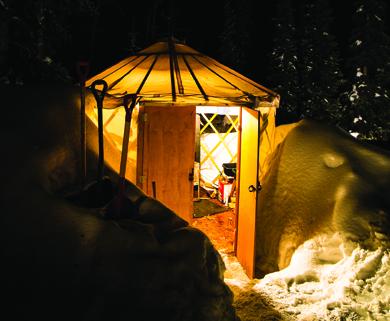
A modern spin on the accommodations the nomadic Mongolian people have been using on the windblown central Asian steppe for more than three thousand years, the design Yurtski uses sits on an elevated platform 20 feet in diameter, its weatherproofed canvas tarpaulin skin stretched over a wooden skeleton.
Two sets of bunk beds flank a central dining table. On either side of the door sit a fully kitted kitchen and a makeshift bar of castaway beer and liquor, left by past guests in a kind of indirect communion with future skiers. On the comfort spectrum, the yurt lies about halfway between glamping and a snow cave.
Although the two yurts are decidedly less mobile than the Mongolian versions, Yurtski’s Forest Service special-use permit requires that they disassemble and remove the yurts every spring.
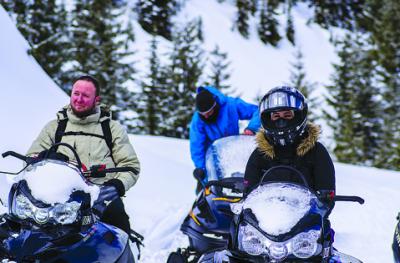
Equal parts guide and gourmet chef, Sievers and his partner Simon offer tailor-made trips, from a simple hand-off of the keys to a fully guided and supported weekend.
At the small kitchen island, Sievers, who works at a restaurant in the off-season, deftly preps multi-course meals for guests in ski bib and fleece pullover: Asian pork lettuce wraps, pad Thai, flourless chocolate torte. No ski-bum pre-packaged rations here.
“We can snowmobile right to the door of the yurts, so we can haul quite a bit of gear for people,” says Sievers. “With our huts, you can bring the gourmet dinner, the bottles of wine, the case of beer and have it be more of a fulfilling experience with friends and family than you would if you had to haul in the essentials on your back.”
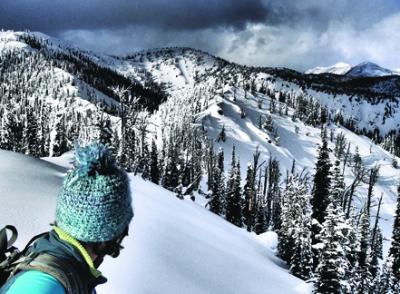
“A lot of the appeal to us as skiers has to do with the immediacy of the area,” says Sievers. “From either area, you basically start skinning up from the front door.”
A series of short, steep bowls that funnel back to the yurts allow for as many—or as few—runs in as one likes; skiers can sleep in, ski Breakfast Bowl and be back in time for lunch. And if conditions aren’t conducive to great skiing in one spot, it’s easy to switch to a different aspect without being committed to a 3,000-foot climb.
I came to the backcountry yurts with a small group with one commitment of my own: learn to ski.
The morning of our stay, I rise before the sun, feed the wood stove, and sneak out the front door of the yurt to watch the sun rise over the Potomac valley.
The afternoon prior we ascended the 11 miles from the valley floor to the yurts, the low fog and insistent din of the snowmobiles further insulating us from the outside world. In the clarity of a late-winter morning, I can see Mt. Morrell and its fire lookout above me and miniature homesteads below.
Back at the yurt, after a leisurely breakfast of scrambled eggs and strong, black camp coffee, our group decides to take an alpine tour.
Carl shows me how to apply the climbing skins, another modern update of an old technology. Synthetics have replaced the literal animal skins, but the concept remains the same: a sheath of angled unidirectional fibers with an adhesive backing, stuck on the bottom of the ski like a fuzzy decal.
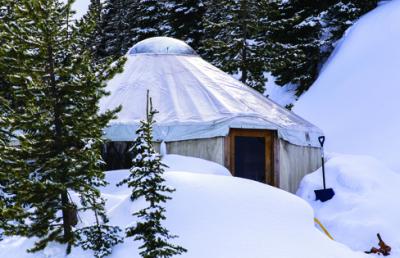
We climb up through the trees behind the yurt on a well-used skin track. Accustomed to the hip-straining slog of snowshoes in deep powder, I marvel at how effortlessly the skis ascend. I settle into the skinning rhythm, lifting one ski, gliding it upward, and setting it down with a subtle shift of weight.
We crest a small knob and stop.
Sievers demonstrates how to set up the skis for alpine mode: set the bindings, lock the boots, peel off, and stow the skins.
I have a vague recollection of the “pizza and French fries” technique. But, accustomed to the single plank of a snowboard, I worry about the two skis running at cross-purposes, my pizza and French fries turning into a pretzel. But when the skis meet the slope they track like two tethered sled dogs down the contours of the forested slope.
I don’t know how to make powder-skiing kick turns, so I learn quickly how to right myself in deep powder. Feeling confident, I point the tips of the skis more into the fall line, figuring that powder is more forgiving than a skied-smooth resort bunny hill.
Back at the yurt, I beam. I’ve just powder-skied through an untracked forested glade an hour’s snowmobile ride from the nearest sign of human habitation—an enviable location for a powderhound, let alone a rank beginner.
“I think a lot of people come up to the yurts just to enjoy the surroundings with friends and family,” says Sievers. “You don’t have to be a hardcore skier to enjoy it.”
He’s right; at the yurt, whether you ski at 3,000 vertical feet or 300, there’s still a cold beverage and warm fire waiting at the end of your run.
The uses for yurts are limited only by the imagination. They have become popular in Montana because of their unique qualities which include strength, comfort, and easy installation. They can blend well with the natural environment while inside the round space and central skylight create a sense of peace and relaxation.î Alan Bair, Pacific Yurts Inc.







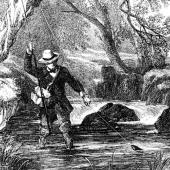




Leave a Comment Here